Overland Mail to California in the 1850s
Between 1789, when the federal government of the United States began, and 1860, the United States’ population grew from about 4 million people to more than 31 million. Its territory extended into the Midwest in 1787 through the Northwest Ordinance, and reached down the Mississippi River and west to the Rocky Mountains after the Louisiana Purchase in 1803.
Until the late 1840s, American emigration to California was a mere trickle, but two events in 1848 opened the floodgates:
- In early February, the Treaty of Guadalupe Hidalgo officially ended the Mexican American War, ceding more than half of Mexico’s former territory to the United States. This included what is now the entire southwestern United States, from Texas to California, and also parts of Wyoming and Colorado.
- Although people at the time did not know it, just a week before the treaty was signed, James Marshall, building a sawmill for Captain John Sutter in Coloma, California, spotted gold in the water near the mill. That August, his discovery became headlines in eastern newspapers, and the Gold Rush was on.
California’s population exploded, and so did the need for connecting this population with the rest of the country – through the U.S. Mail.

The first U.S. Mail traveled to California by steamship, via the Isthmus of Panama, in 1848. The ocean routes via Panama remained a vital link in the nation’s mail system until the completion of the transcontinental railroad in 1869.
In November 1848, Postmaster General Cave Johnson dispatched a special agent to California to establish Post Offices. By Christmas, steamships were carrying mail from New York to California via the Isthmus of Panama. This was before the construction of the canal. When the ships reached Panama, the mail was taken off and transported in canoes or on pack animals – and later by railroad – about 50 miles to the Pacific coast. Another steamship collected the mail on the Pacific side and headed north.
In the 1850s, Congress authorized four mail routes that linked the new settlers in California with the rest of the nation over land. Congress authorized funding for the overland routes not because they brought any financial profit to the Post Office Department or the federal government, but because they helped build and bind together a nation. The mail contractors and carriers were pioneers, finding or creating the best routes of travel and building supply stations that later eased the way for emigrants heading west.
First Overland Mail to California: Central Route via Salt Lake City
The first overland mail service to California came via the central route, by way of Salt Lake City. In the spring of 1851, Absalom Woodward, who was 50 years old, and George Chorpenning, who was 30, agreed to carry mail from Salt Lake City to Sacramento. (Mail had been carried between Independence, Missouri, and Salt Lake City since the previous year.) For $14,000 a year Woodward and Chorpenning agreed to leave from each end of the route once a month and complete the trip in 30 days. Both were Pennsylvania natives who had met in California. They soon found that transporting mail in the West was easier promised than accomplished.
Chorpenning started east from California on May 3, 1851, and reached Salt Lake City the next month without too many problems. However, when Woodward led another eastbound trip later that summer, he was not so lucky. He was riding 10 miles ahead of the main party, when he was pursued by Indians. Only his faster horse saved him.
When Woodward headed back to Sacramento in August, his mail train was ambushed by Indians. In September, Indians killed two mail carriers, and the next month, attacked once more. The carriers managed to escape, but lost the mail.
In November 1851, Woodward and his mail party left California for Salt Lake City. They never made it. Woodward’s body was found the following April, but no mail. The mail party apparently had been killed by Indians.1

George Chorpenning’s mail routes for the carriage of mail from Salt Lake City to California (modern depiction, on 1858 War Department map in the collection of the Library of Congress).
Weather also posed a great hazard. Three eastbound carriers made it through deep snow in the Sierra Nevada Mountains that winter, but it took them two months to reach Salt Lake City. They reached it on foot, reportedly having survived by eating their own mules, which had frozen to death in blizzards.2
Stumped by the snowy Sierras, Chorpenning redirected the mail to avoid the mountains. From San Francisco, he sent the mail south by steamship to San Pedro, near Los Angeles, and then overland to Salt Lake City via the Mormon Trail.
Californians complained about not getting their mail regularly. The Postmaster General cancelled Chorpenning’s contract and gave it to someone else, but Chorpenning traveled to Washington, D.C., and successfully argued for its reinstatement. His company continued to carry the mail, using the Mormon Trail via San Pedro during the winter months, through July 1854.
In 1854, Chorpenning contracted with the Post Office Department to carry mail once a month from Salt Lake City to San Diego for four years (about four months into the contract the route’s western terminus was changed to San Pedro). Mail was carried on horseback, by pack mules, or in wagons. Chorpenning agreed to carry the mail for $12,500 a year, thinking that Congress would increase his pay, and he was right. Congress more than doubled it, to $30,000 a year, retroactively.
Chorpenning signed a new four-year contract in 1858, agreeing to carry mail every two weeks between Salt Lake City and Placerville, California, for about $34,000 a year. By the time service started that July, the route had been improved to weekly, and his pay nearly quadrupled. By December 1858, he routed his coaches along the more southerly Egan Trail, which cut about 100 miles off the route. This was part of the route later used by Pony Express riders.
Chorpenning hired John A. “Snowshoe” Thompson to ensure that the mail made it through the Sierras in winter. Thompson, Norwegian by birth, was a local legend for carrying mail through heavy snows. When necessary, he packed the mail on his back and used cross-country skis – at the time called “snowshoes” – to deliver it.
Hoping to prove that the central route was the quickest to the West, in December 1858, Chorpenning arranged with the contractors who carried the mail to Salt Lake City to deliver President James Buchanan’s second annual message to Congress to the West Coast in record time. They made it in 17 days. At least one historian thinks the concept of the Pony Express may have grown from this 1858 express run.3
Horace Greeley, editor of the New York Tribune, traveled with the mail stage from Laramie, Wyoming, to Placerville, California, in 1859. He described the experience in his book An Overland Journey. By the time Greeley traveled, the route was well-established, but travel was still a challenge. It relied upon mules, and mules could not always be relied upon. Greeley wrote about fording the Laramie River that the group “had the usual trouble with mules turning about in mid-stream, tangling up the team, and threatening to upset the wagon.”4 On another day, Greeley saw that
at the very first crossing, one of our lead-mules turned . . . and ran into his mate, whom he threw down and tangled so that he could not get up; . . . in a minute another mule was down, and the two in . . . danger of drowning.5
The mules survived, but Greeley’s luggage did not. His carpetbag was fished out, but, to his great distress, his trunk was left at the bottom of the Sweetwater River.
San Antonio to San Diego Route
In 1857, the Post Office Department opened up another artery to the West when it contracted with James Birch, the former president of the successful California Stage Company, for twice a month service between San Antonio, Texas, and San Diego, California. (Mail arrived at San Antonio from the East by way of New Orleans.) Birch hired Isaiah Woods to oversee the mail service. Unfortunately, neither man, it seems, had ever traveled the route, and later this would cost them.
Woods sent someone from New York to San Antonio to buy stock and equipment for the east end of the line. He asked Robert Doyle, of San Francisco, to prepare and run the western end of the line. Woods himself rushed from New York to San Antonio. (Rushing back then took about two weeks by train, steamship, and stagecoach.) In San Antonio, Woods was aided by George Giddings, who had been carrying mail for three years from San Antonio to Santa Fe and owned stock and equipment.
The first mail left San Antonio on July 9, 1857. Woods went with it, struggling to get enough mules to get the mail through. Mules were scarce. Indians had attacked one of his wagon trains, taking 21 mules, so Woods borrowed 36 more from the commanding officer at Fort Davis – then made a permanent enemy of the man when he did not return all the mules, as promised.
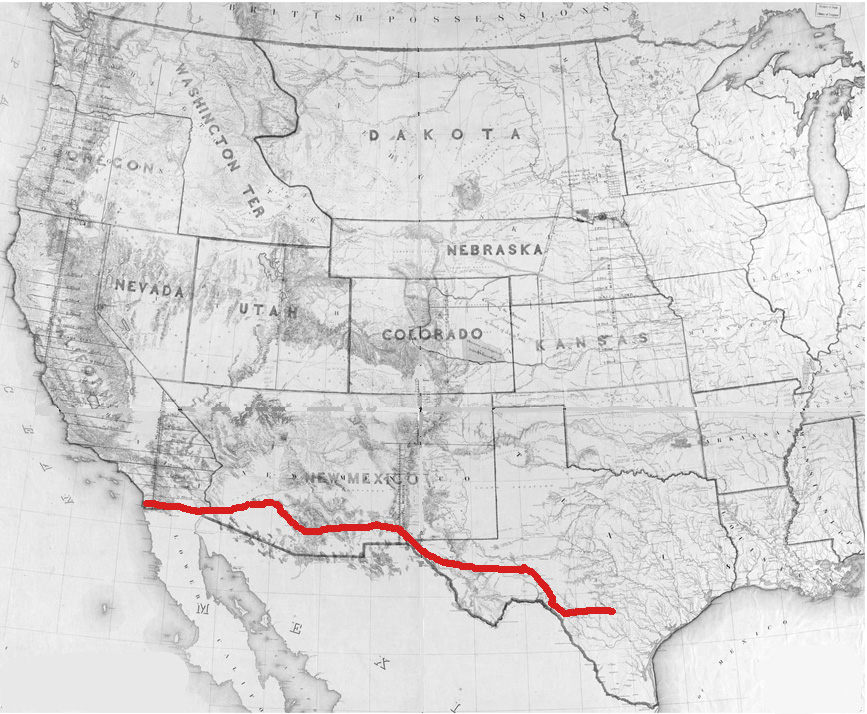
San Antonio to San Diego, June 1857 to September 1858 (modern depiction, on 1858 War Department map in the collection of the Library of Congress).
Woods also struggled with equipment. The first coaches he bought were too heavy. Their weight, combined with the weight of the mail and the “continual ascent of the roads,” was too much for the mules.6 He tried two lighter carriages, but neither was strong enough. Finally, near Fort Fillmore (New Mexico), he found a suitable second-hand wagon and, about 48 miles later along the trail, an adequate carriage. Woods complained: “This made four carriages I had purchased . . . before getting two which were even temporarily fit for carrying the mail.“7
The mail party traveled from about 25 to 70 miles a day, taking 38 days to complete the nearly 1,500-mile trip. Woods arrived in San Diego on September 8, 1857. He had planned to meet James Birch there – to get money to pay his bills, for one thing – but learned that Birch had left California weeks earlier to return to New York via steamship.
Just days later, on September 12, 1857, the U.S. Mail steamship Central America, on which Birch had been traveling, sank off the coast of the Carolinas (story below). Birch did not survive.
Woods learned of Birch’s death two months later. He continued to carry out the terms of Birch’s contract until January 18, 1858, when Birch’s widow revoked his authority to do so. In March, the contract was transferred to George Giddings, who continued the service. When the Butterfield Overland Mail started in September 1858, the El Paso to Yuma section of the route, which followed the same trail, was discontinued, while service on the remaining sections increased from every two weeks to once a week.
Phocion Way, a 31-year-old from Cincinnati, Ohio, traveled along this route as far as Arizona in the spring of 1858. He described dinner on the trail as “bad beans and bad bacon poorly cooked.”8 When there was time to sleep, travelers rolled themselves up in blankets and slept under the stars. He noted that
every man, no matter what his business, goes well armed at all times. . . . Every man must do that here or he will soon be rubbed out.9
To discourage Indian attacks, mail parties traveled in large groups. Sometimes vehicles and stock could be changed from station to station, and sometimes not. Rarely, the wagons were pulled by horses and traveled at a good speed. More often, mules did the job. Sometimes passengers had to walk to relieve overworked mules. During Phocion Way’s trip, at one point passengers not only had to walk but actually had to help push the mail wagon up a mountain.
The Sinking of the Central America
On Tuesday, September 8, 1857, the U.S. Mail steamship Central America, en route from Panama to New York, left the port of Havana loaded with nearly 600 passengers and crew along with tons of mail and freight, including an estimated 21 tons of gold. The next day, the winds picked up and grew in fury. By Friday, the ship’s crew was battling a hurricane; that morning, the ship sprang a leak. For nearly 24 hours, the men on board – passengers and crew alike – helped bail, but their efforts were not enough. The ship filled with water and the fires that powered the engines died, leaving the ship at the mercy of mountain-high waves.
For a few hours on Saturday, September 12, the storm abated. A passing ship, the Marine, approached to render aid. All the women and children on board and about 40 male passengers and crew – nearly 100 in all – were put in lifeboats and made it safely to the Marine before that ship, which was also storm-damaged, drifted out of reach. Meanwhile, the storm once again began to rage.
That night, the Central America slipped under the waves. More than 400 passengers and crew went down with the ship. About 50 survivors were plucked from the sea by a passing ship the next day; 3 more were rescued nine days later, after drifting for more than 400 miles.
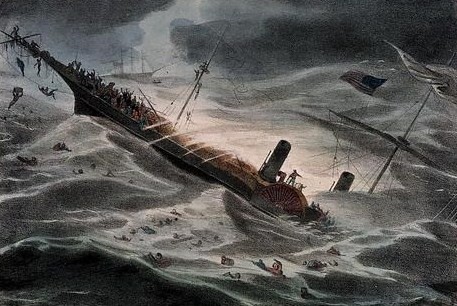
Lithograph by J. Childs, 1857 (courtesy Wikisource)
At the time, the Sinking of the Central America was a tragedy as big as the sinking of the Titanic would be a half-century later. The loss of its gold shipments contributed to the Panic of 1857 and the ensuing financial recession.
In 1988, a deep-sea salvage company located the remains of the Central America and its golden treasure in more than 8,000 feet of water about 200 miles off the coast of the Carolinas.
For more information on the ship’s wreck and recovery, see Ship of Gold in the Deep Blue Sea, by Gary Kinder (New York, NY: Atlantic Monthly Press, 1998).
Butterfield’s Overland Mail Route
The third route to California was the longest and most legendary – the Butterfield Overland Mail.
In 1857, Congress authorized the Postmaster General to contract for the carriage of letters from somewhere on the Mississippi River – it would be the contractor’s choice – to San Francisco for six years. The mail was to be carried using “good four-horse coaches or spring wagons, suitable for the conveyance of passengers” (11 Stat. 190).
Congress wanted the contractor to choose the location of the route because Congress itself could not. Southern congressmen wanted it in the South; Northern congressmen wanted it in the North. More was at stake than the mail – everyone believed this route would determine the path of the future transcontinental railroad.
The day after the bill passed, Aaron Brown of Tennessee was appointed Postmaster General. Brown, a southerner, favored a southern route. Although Congress had specified that the contractor choose the location of the route, when none of the proposed routes were southern enough, Brown himself dictated the route: from St. Louis and Memphis, converging at Little Rock (soon changed to Fort Smith), then on to San Francisco via El Paso and Yuma. All the bidders for the route agreed to follow this course. Brown assigned the contract to John Butterfield and company, whom he considered best able to provide the service.10
Having two starting points for the route – St. Louis and Memphis – was an attempt to appease both northern and southern interests, but the bulk of the route hugged the southern U.S. At a couple places, it was right along the Mexican border. West of Yuma, for about 70 miles, the route was actually in Mexico.11 The New York Times howled
What possible object there can be in selecting this extreme Southern route we are utterly unable to conceive, unless it is that of forcing the future railroad to take an unnatural course, such as neither buffalo, emigrants nor capital would ever select.12
In his Annual Report, Brown included an elaborate, 18-page defense of his choice. The route via Salt Lake, he noted, was “entirely out of the question” because “snow caused almost an entire failure for four months of the year.”13 He included a page and a half of weather data to show that a route via Albuquerque would be so cold it would not only make passengers uncomfortable, it might actually kill them.14 By contrast, “the southern or El Paso route,” he stated, was “eminently comfortable and desirable for winter emigration.”15 He continued:
For nearly a thousand miles the traveler will be traversing a country abounding in beauty and in healthfulness, possessing a salubrious climate and a fruitful soil.16
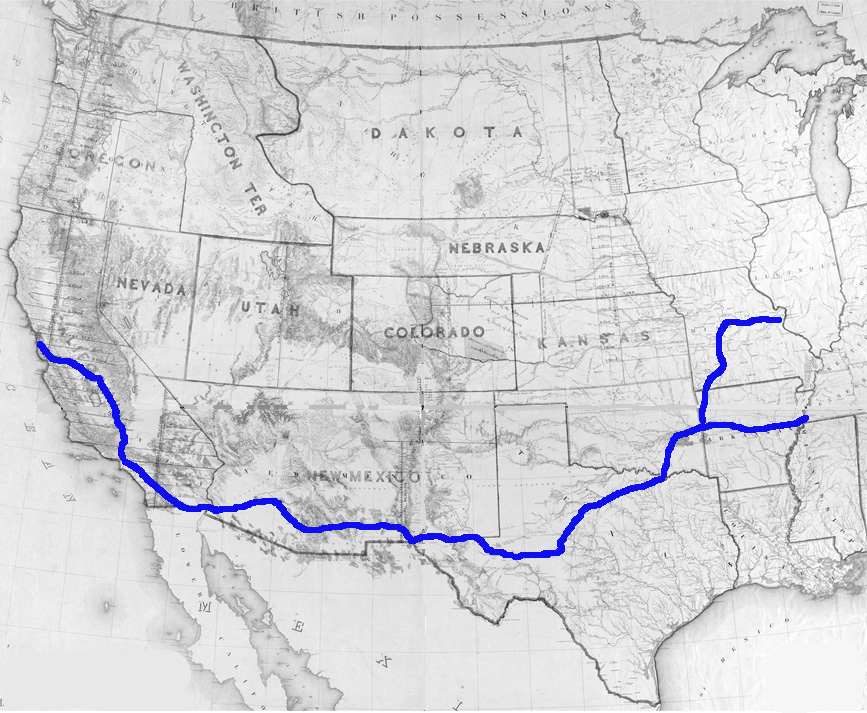
St. Louis and Memphis to San Francisco, September 1858 to March 1861 (modern depiction, on 1858 War Department map in the collection of the Library of Congress).

Departure of the Butterfield Overland Mail from San Francisco, depicted in the December 11, 1858, issue of Harper’s Weekly.
A second opinion, by Rhode Island’s Secretary of State, was not as glowing but still positive. He wrote that the route offered 50- to 100- miles of visibility most of the time, and the country was well-suited to wagon traffic.17
The contract with Butterfield and his associates was signed in September 1857, to go into effect within a year. Butterfield and company agreed to carry the mail through in 25 days, twice a week, for six years, at $600,000 a year. As scheduled, mail started from each end of the nearly 2,800 mile-long route in September of 1858. The first westbound trip was made in about 24 days; by 1859 the average trip time was about 21 ½ days. Even the loudest critics of the route’s location had no complaints about the service.
Waterman Ormsby, a special correspondent to the New York Herald, traveled as a passenger on the first westbound trip and reported his experiences in a series of articles for the Herald. Ormsby reported that at Springfield, Missouri, the mail party switched from a Concord coach to a stronger, canvas-topped wagon. Coaches could squeeze nine passengers inside and an indefinite number on the roof. Wagons could comfortably accommodate three or four passengers, but often carried six. Travelers were in motion day and night, stopping only for meals and to switch out stock or equipment at stations placed from 9 to about 60 miles apart. On approaching a station, the conductor would blow a horn so fresh mules or horses would be ready and waiting.
Early in his trip, Ormsby optimistically noted “we had now gone two hundred and forty-three miles, through, I think, some of the roughest part of the country on the route. . . I find roughing it on the Plains agrees with me.”18 Two days later he changed his mind:
I had thought before we reached this point that the rough roads of Missouri and Arkansas could not be equalled; but here Arkansas fairly beats itself. I might say our road was steep, rugged, jagged, rough and mountainous – and then wish for some more expressive words. . . . Our heavy wagon bounded along the crags as if it would be shaken in pieces every minute, and ourselves disembowelled on the spot.19
Ormsby reported many mule-related delays. “The mules reared, pitched, twisted, whirled, wheeled, ran, stood still, and cut up all sorts of capers.”20 In fear for his life, at one point he got off the wagon and walked, and was glad that he did, for the harness soon became tangled, the wagon wrecked, and the two lead mules escaped. The wagon driver disentangled the harness and continued the trip with only two mules. Against his better judgment, Ormsby got back on the wagon, although he wrote that “if I had any property I certainly should have made a hasty will.”21
Kansas City, Missouri, to Stockton, California
A fourth overland route to California, from Kansas City to Stockton, was established in 1858. Few trips were made – allegedly due to hostile Indians – and, reportedly, only three letters were ever carried the entire length of the route.22 The route was discontinued less than a year later.
Route Reductions
During the two-year term of Postmaster General Aaron Brown, from March 1857 to March 1859, the number of overland mail routes to California had increased from one to four. Brown not only increased the number of routes, but also increased the number of trips on existing routes.
Californians were delighted. Senator William Gwin of California considered the liberal establishment of mail routes “one of the most important policies ever adopted by this Government.”23 Not everyone agreed. The routes to California were huge money-losers for the Post Office Department – costing more than $2 million in 1859 and earning less than 1/6 that amount in postage collected.
Postmaster General Brown died unexpectedly on March 8, 1859. His successor, Joseph Holt of Kentucky, believed the Post Office Department should pay its own way. He criticized the “enormous sums” paid to stagecoach companies to transport mails, “some of which [were] so light as scarcely to yield a revenue sufficient to defray the expense of carrying them on horseback.”24 Holt slashed the cost of mail transportation nationwide. He cut the number of trips on the San Antonio to San Diego route in half and did the same on the central route via Salt Lake City. Both went from weekly to every other week. Not only was the contractors' pay reduced, but Congress delayed paying them, which pushed Chorpenning into bankruptcy. His route was later reassigned.
Postmaster General Holt discontinued the monthly mail to Stockton, which, at any rate, had never operated regularly. He did not cut service on the Butterfield route, but only because the U.S. Attorney General advised him that the contract terms would not allow it.
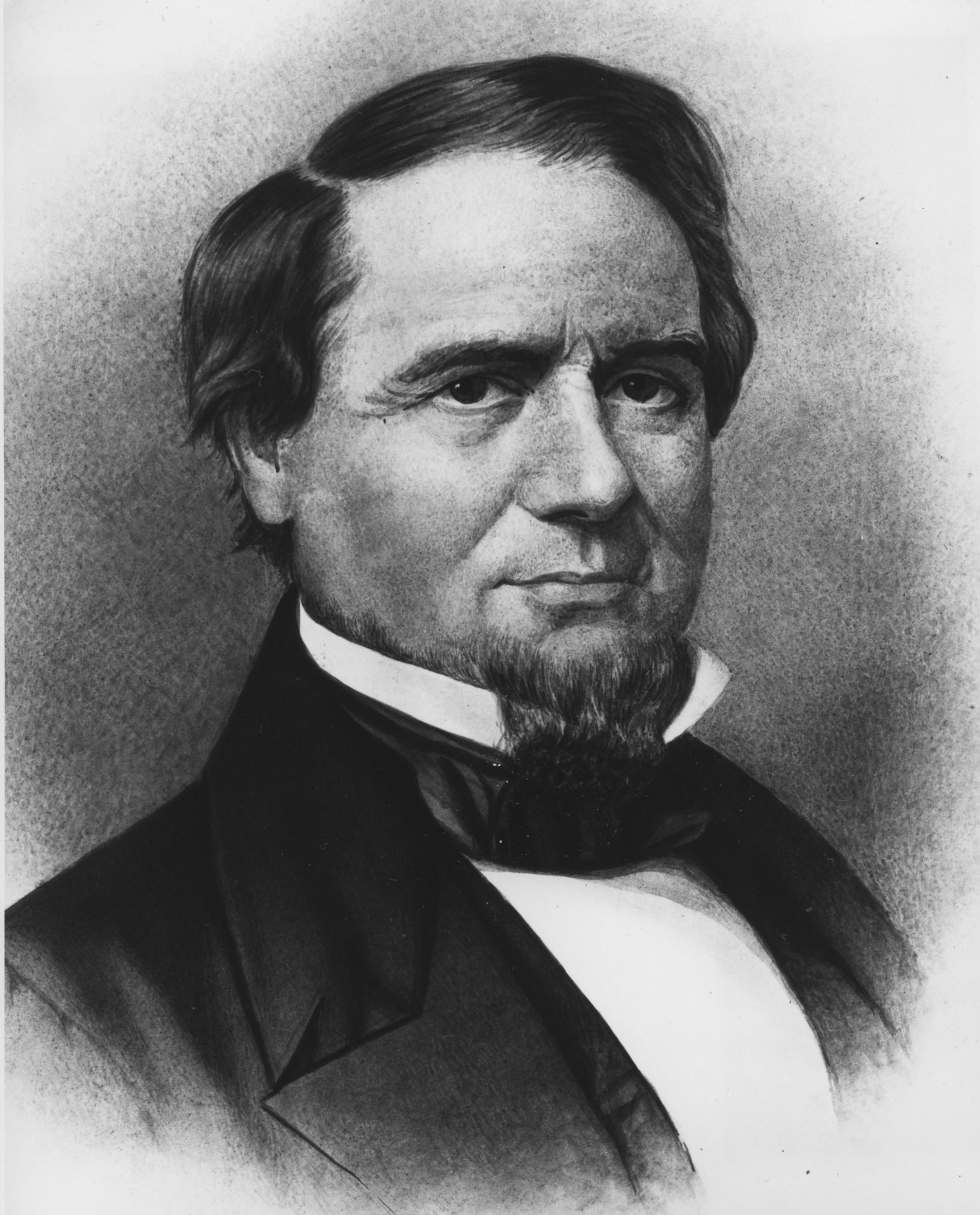
Aaron Brown, Postmaster General, March 1857 – March 1859
Although the Civil War disrupted service in the South, mail continued to be carried to California, both by stagecoach and steamship, until the completion of the transcontinental railroad in 1869. In his 1858 Annual Report, Postmaster General Aaron Brown noted that the routes to California were established mainly for national goals – “the extension of our commerce, the spread of our population, and the development of the various resources of our country.”25 He acknowledged that none of the mail routes to California ever paid more than half their expense in postage collected, but considered that the nation had been, “in her trade and commerce, remunerated a thousand fold.”26
HISTORIAN
UNITED STATES POSTAL SERVICE
AUGUST 2010
Overland by Stagecoach
Crossing the country by stagecoach was adventurous even by nineteenth-century standards. William Tallack, who traveled east by stagecoach in 1860, noted that “not one in a hundred travellers go eastward by the Overland on account of its risks and discomforts” (Lang, First Overland Mail, 129). Tallack observed that traveling by ship via Panama, though more than twice the distance, was just as fast, and generally more comfortable.
Stagecoach passengers risked death or injury if coaches were attacked by robbers or Indians. Bad roads, though less fearsome, were a more persistent danger – at their worst, they overturned coaches, and at their best, bruised passengers.
Edmund Hope Verney, a lieutenant in the British Royal Navy who had seen battle in the Crimean War and India, traveled overland from California to Kansas in 1865. In an article in the June 1866 issue of London’s Good Words and Sunday Magazine, Verney recalled: “I can remember no night of horror equal to the first night’s travel on the Overland Route.” He described jolts to the carriage that would “strike the cranium violently against the roof.” The carriage was so crowded, he wrote, that
not only was there a difficulty about stowing away one’s feet, but we had even to fit in our knees one with another, and then occasionally give and take pretty smart blows caused by the jostling of the carriage.
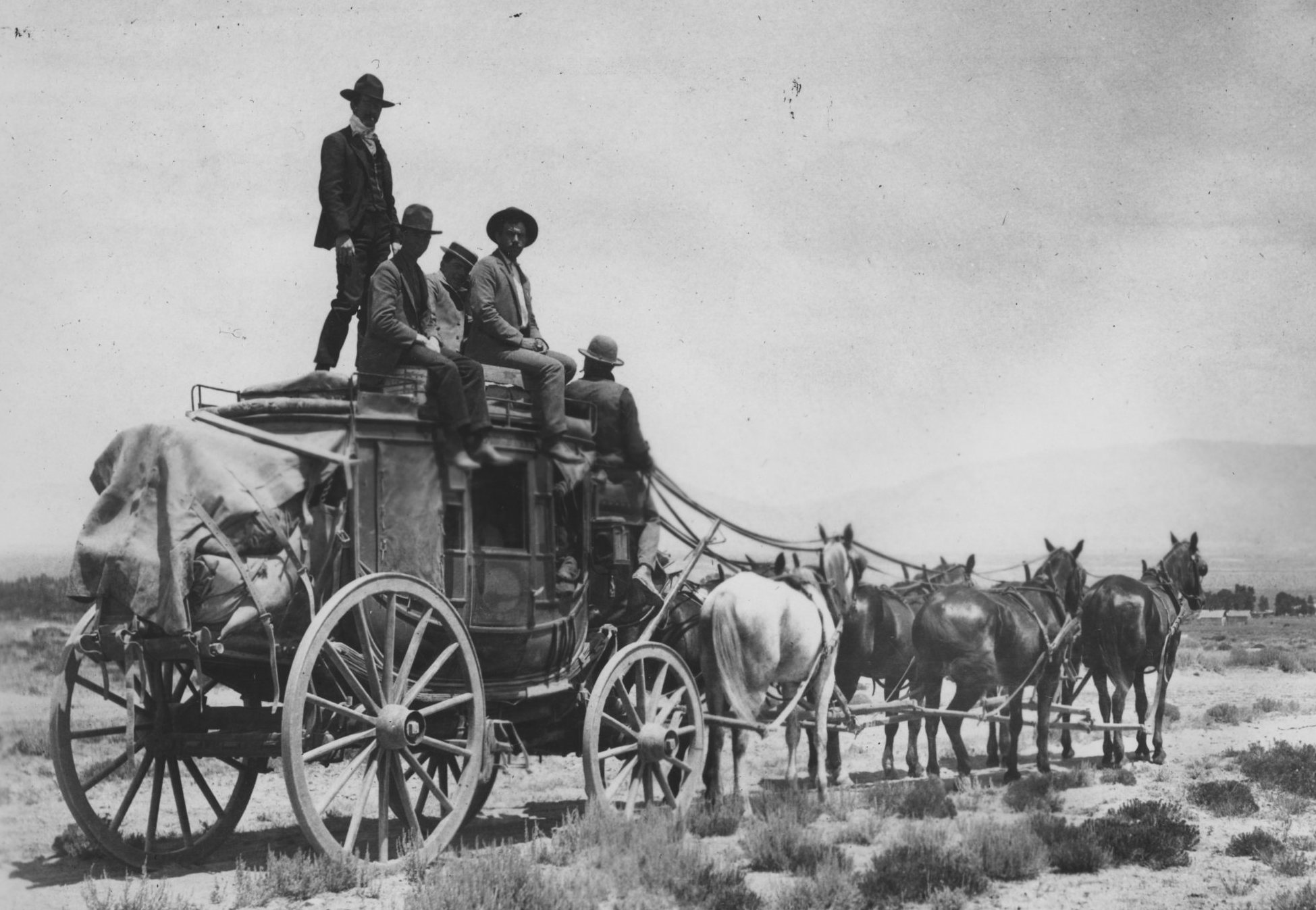
Wyoming, circa 1900
Weyle and Barber, photographers
Nine people could squeeze inside a stagecoach; additional passengers sometimes traveled on the roof. Inside, three lucky passengers had the back seat. Three passengers sat in the middle seat, which had only a leather strap for a backrest, and three sat in the front seat, facing backwards. Middle- and front-seat passengers faced each other and had to interlock their legs. Through-passengers remained sandwiched together for about 22 days, with only brief stops for meals and changes of stock or equipment.
Endnotes
1 Although some Indians were friendly to and even aided mail carriers, others resented the invasion of their homeland. By easing the way for later emigrants, the first mail carriers were, in a sense, the vanguard of that invasion.
2 John M. Townley, “Stalking Horse for the Pony Express: The Chorpenning Mail Contracts between California and Utah, 1851-1860,” Arizona and the West, Vol. 24, No. 3 (Autumn 1982), 234.
3 Ibid., 245.
4 Horace Greeley, An Overland Journey, from New York to San Francisco in the Summer of 1859 (New York, NY: C.M. Saxton, Barker & Co., 1860), 182-183.
5 Ibid., 186.
6 J. C. Wood (sic), Report to Hon. A.V. Brown, Postmaster General, on the Opening and Present Condition of the United States Overland Mail Route Between San Antonio, Texas, and San Diego, California, March 1858, 12
(http://name.umdl.umich.edu/AFT3376.0001.001, accessed 4/19/2010).7 Ibid., 15.
8 William A. Duffen, ed., “Overland via ‘Jackass Mail’ in 1858, The Diary of Phocion R. Way,“ in Arizona and the West, Vol. 2, No. 1 (Spring, 1960), 52.
9 Ibid., 42-44.
10 Butterfield and company had initially wanted to carry the mail via Albuquerque – more than 200 miles to the north.
11 Walter B. Lang, ed., The First Overland Mail: Butterfield Trail, St. Louis to San Francisco, 1858-1861 (unknown binding, 1940), 129.
12 New York Times, June 25, 1857, 4.
13 Annual Report of the Postmaster General, 1857, 34.
14 Ibid., 37.
15 Ibid., 37.
16 Ibid., 44.
17 Letter from John R. Bartlett to the The Providence Journal, reprinted in the August 21, 1857, issue of the New York Times. Bartlett had explored the Southwest in the early 1850s in connection with the United States Boundary Commission.
18 Lang, First Overland Mail, 43.
19 Ibid., 44.
20 Ibid., 61.
21 Ibid., 62.
22 Jesse L. Coburn, Letters of Gold, California Postal History Through 1869 (Canton, OH: U.S. Philatelic Classics Society, 1984), 244.
23 Le Roy R. Hafen, The Overland Mail, 1849-1869: Promoter of Settlement, Precursor of Railroads (Cleveland, OH: The Arthur H. Clark Company, 1926), 131.
24 Annual Report of the Postmaster General, 1859, 16.
25 Ibid., 1858, 14.
26 Ibid., 13.
